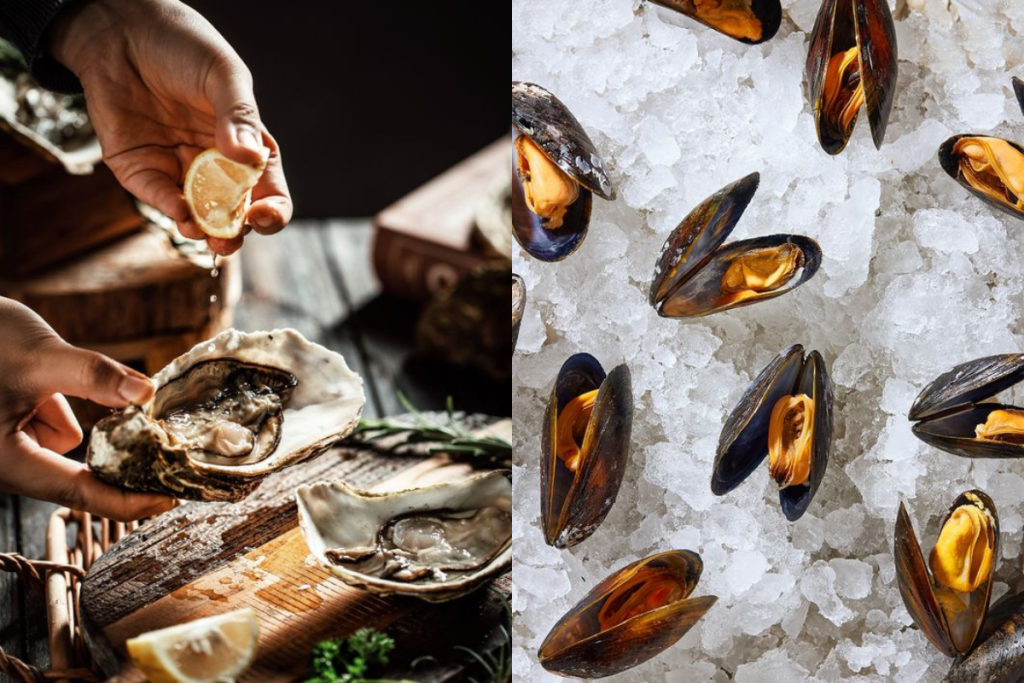If you’re a fan of seafood, you’ve probably come across both mussels and oysters. These tasty shellfish might look alike at a glance, but they’re actually quite different in terms of taste, nutrition, and where they come from. So whether you’re a seafood newbie or a seasoned shellfish lover, here’s a friendly guide to help you navigate the world of mussels and oysters!
The Basics: Mussels vs. Oysters
Both mussels and oysters are bivalve mollusks—meaning they have two hinged shells—but that’s where the similarities start to drift apart. Mussels belong to the Mytilidae family, while oysters come from the Ostreidae family. They’re both filter feeders, happily munching on plankton and tiny particles by filtering water through their gills.
But when it comes to where they live, mussels are like the adventurous backpackers of the shellfish world, thriving in both freshwater and saltwater. Oysters, on the other hand, are beach bums, sticking to coastal, brackish, or saltwater environments.
Nutritional Showdown: Mussels vs. Oysters
When it comes to nutrition, both mussels and oysters are seafood powerhouses. But they each bring something different to the table.
- Mussels are packed with vitamin B12, iron, and omega-3 fatty acids. They’re excellent for keeping your blood, brain, and heart in tip-top shape.
- Oysters are famous for their high zinc content, which is great for your immune system and wound healing. They’re also a solid source of vitamin D and copper.
Here’s how they compare nutritionally:
| Nutrient | Mussels (100g, Raw) | Oysters (100g, Raw) |
|---|---|---|
| Calories | 172 kcal | 73 kcal |
| Protein | 24 g | 9 g |
| Fat | 4 g | 2 g |
| Zinc | 12 mg | 16 mg |
| Vitamin B12 | 12 µg | 16 µg |
Fun Fact: Oysters’ high zinc content is why they’re often considered an aphrodisiac—so if you’re looking to spice things up, oysters might be your shellfish of choice!
Culinary Uses: How They’re Served Up
- Mussels are typically cooked and served in their shells, often steamed with white wine, garlic, and herbs (yum!). They’re the stars of dishes like moules marinières or seafood stews. Mussels are versatile and can also be grilled, sautéed, or tossed into pasta.
- Oysters are often eaten raw (on the half-shell), with a squeeze of lemon or a dash of mignonette sauce. But if raw seafood isn’t your thing, they’re also amazing grilled, baked (think oysters Rockefeller), or even deep-fried in a classic po’boy sandwich.
Taste Test:
- Mussels have a mild, slightly sweet flavor and a tender yet chewy texture.
- Oysters are briny, with a sea-salty taste that varies depending on where they’re harvested.

On the topic:
Trout vs Salmon: A Fishy Showdown
Tuna vs Salmon: The Ultimate Seafood Debate
Oat Milk vs Almond Milk: The Ultimate Showdown
Environmental Impact: Seafood that’s Good for the Ocean
Here’s the best part: both mussels and oysters are super sustainable! They’re great for the environment because they act as natural water filters, helping to improve water quality by removing pollutants.
- Mussels are easy to farm sustainably and require little feed or resources.
- Oysters not only clean the water, but they also contribute to forming oyster reefs, which provide habitats for other marine life.
However, wild populations can be affected by overharvesting, so it’s important to enjoy farmed varieties whenever possible.
Health Benefits: Shellfish with Perks
- Mussels are rich in omega-3 fatty acids, which support heart health, reduce inflammation, and improve brain function.
- Oysters, thanks to their zinc content, are great for your immune system, skin health, and even hormone production.
But there’s a catch: eating raw shellfish can carry some risks, including exposure to bacteria like Vibrio and viruses like norovirus. Always buy shellfish from reputable suppliers and, if in doubt, cook them to be on the safe side!
FAQs: Mussels vs. Oysters
Can I eat raw mussels?
While oysters are often enjoyed raw, mussels are usually cooked. Eating raw mussels isn’t common, as they carry a higher risk of bacteria and toxins.
Which has more zinc, mussels or oysters?
Oysters win the zinc battle hands down! They have almost double the zinc content of mussels, making them the better choice for immune support.
What’s the difference between mussels and clams?
While they look similar, clams are usually rounder, and their flavor is brinier than mussels. Clams are often eaten raw or in dishes like clam chowder.
Which is better, mussels or oysters?
That’s a matter of taste! If you love the fresh, briny flavor of the ocean, go for oysters. If you prefer something sweeter and more delicate, mussels are your best bet.
Mussels vs oysters taste: What’s the main difference?
Mussels have a mild, sweet taste with a tender chew, while oysters are briny and taste like the ocean.
Mussels vs oysters nutrition: Which is healthier?
Both are incredibly healthy, but it depends on what you’re looking for! Mussels are higher in protein and omega-3s, while oysters pack a punch with zinc and vitamin D.
Clam vs oyster vs mussel: How can I tell them apart?
- Mussels have elongated, smooth shells.
- Oysters are rough, irregularly shaped, and often larger.
- Clams are rounder with a smooth, symmetrical shell.
Final Thoughts: Mussels or Oysters?
In the end, whether you’re team mussel or team oyster, both bring their own unique flavors, textures, and health benefits to the table. Enjoy mussels for their mild sweetness and versatility in cooked dishes, or savor the briny burst of flavor from a fresh oyster on the half shell. Either way, you can’t go wrong with these ocean delicacies!
So, what’s it going to be for your next seafood feast? Let your taste buds decide!

